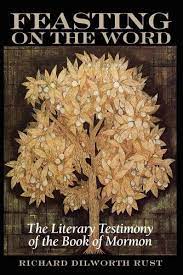Articles/Essays – Volume 32, No. 2
The Book of Mormon as Great Literature | Richard Dilworth Rust, Feasting on the Word
A number of years ago when I was attending Bowling Green University as a graduate student, I was introduced to the writings of John Muir, the American naturalist. One of the approaches we used in studying Muir was to look at his long narratives and extract passages that were particularly lyrical—poetic. By way of illustration, my professor provided me with several passages poet Gary Snyder had extracted from Muir’s work and transposed from prose to poetry. The power of Muir’s works jumped off the page. It was because of those few poems that I arrived at the topic for my thesis. I chose to explore the poetic and lyrical passages in a number of Muir’s books tracing his growth as a poet and a transcendentalist. In his book, Feasting on the Word, Richard Dilworth Rust examines the Book of Mormon for its poetic and literary quality. There can be no question of the importance of the Book of Mormon as a divinely inspired scripture, but seldom is it considered as a monumental piece of literature. The treatment it receives at the hands of Rust places it solidly in the category of not only good literature, but his case for it as great literature is so well founded, it must be accepted without argument.
His approach is that of solid scholarship, and he avoids the didacticism that comes so naturally when dealing with religious writings. I heard Raymond Carver, the American short story writer and poet, once say that his stories needed to be read aloud; in fact it was his contention that all literature is better when it can be experienced on as many sensory levels as possible. Rust, in explaining how he came to this project, told of reading passages from the Book of Mormon aloud to his children and how the poetics became very apparent. By extracting lyrical passages such as 2 Nephi 4:15-16 and transposing them from chapter and verse into poetic verse, Rust makes clear his contention that the Book of Mormon is not only of theological value, but of important literary value as well.
For my soul delighteth in the
scriptures,
and my heart pondereth them,
and writeth them for the learning
and the profit of my children.
Behold, my soul delighteth in the
things of the Lord;
and my heart pondereth continu-
ally upon the things which I
have seen and heard.
Rust’s argument is further strengthened by his clear comparisons with such revered writers as Shakespeare and Nathaniel Hawthorne for both style and content. The book is divided into chapters by topical ideas all leading to the conclusion that great literature is that which inspires the reader and elevates the human spirit. The di visions are as follows: introduction, narrators and narratives, epic elements, poetry, sermons, letters and autobiography, imagery, typology, and larger perspectives. By exploring the Book of Mormon from such perspectives, Rust adds a sustaining vote of support to a truly epic piece of literature and inspired work of art. He calls it “an active epic . . . [that] give[s] meaning to humankind’s general des tiny” (64).
The broad scope of Feasting on the Word is another scholarly aspect that weighs in its favor. For instance, when discussing the literary value of the “letters” of the Book of Mormon, Rust uses a definition of the term “letters” by Hugh Walpole: “[letters] ought to be nothing but extempore conversation upon paper” (149). According to Rust, the letters found within the Book of Mormon “have claim to be examined as literature because they engage our interest both for what they say and for the way in which they are expressed. The imagery found within the Book of Mormon’s text is also of great import in describing its literary value. According to C. Day Lewis and N. Friedman: “Imagery in a literary sense is ‘a picture made of words’ . . . and ‘refers to images produced in the mind by language . . .'” (167). By way of illustration, Rust cites Alma 26:5-7 as to “the vividness and clarifying power of imagery” (168) found in the Book of Mormon:
The field was ripe, and blessed are ye, for ye did thrust in the sickle, and did reap with your might, yea, all the day long did ye labor; and behold the number of your sheaves! And they shall be gathered into the garners, that they are not wasted. Yea, they shall not be beaten down by the storm at the last day; yea, neither shall they be harrowed up by the whirlwinds; but when the storm cometh they shall be gathered together in their place, that the storm cannot penetrate to them; yea, neither shall they be driven with fierce winds whithersoever the enemy listeth to carry them. But behold, they are in the hands of the Lord of the harvest, and they are his; and he will raise them up at the last day.
Feasting on the Word is an extremely well done piece of scholarship. It is insightful and thorough in dealing with what Joseph Smith said is the “cornerstone” of Mormon theology— The Book of Mormon. Richard Rust is correct in stating: “On each rereading, the book becomes more significant, deep, and powerful . . .” (219); Rust’s work helps clarify just how deep and powerful.
Feasting on the Word. By Richard Dilworth Rust (Salt Lake City: Deseret Book Co., 1997).


 Back to full Issue
Back to full Issue

